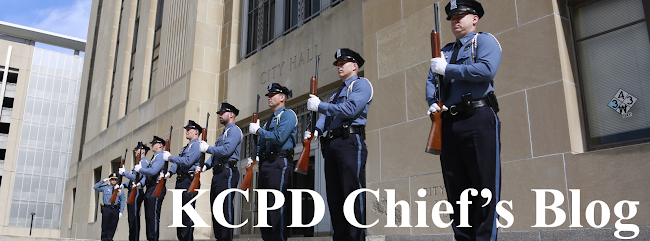Over the
past three years, I have had the pleasure of leading an organization filled
with talented, dedicated, compassionate and professional employees. Since being
appointed chief of police on October 13, 2011, I have experienced a tremendous
amount of personal and professional growth thanks to many.
Both my
immediate and extended family have been nothing but supportive and encouraging
during my entire 29 years of employment with the Kansas City Missouri Police
Department. I am so blessed and
appreciative to have them in my life. Same goes for my few close groups of
friends who look out for my well-being, several of whom contact me daily.
My
faith-based supporters are very much appreciated as they have prayed for me
regularly as well as remind me that I work for God and not for man. Oftentimes I have made decisions that
others question, which I encourage and welcome, but please know that I pray
before making most major decisions and will follow the guidance of my heavenly
Father. Thus far, when I have listened to him, many crises have been averted.
What I am
most encouraged about during my tenure as chief is the reduction in the number
of homicides in Kansas City. The reduction in the number of homicides committed
this year is unparalleled during the past five decades. The credit for the
reduction is only in part due to the efforts of the police department. Many
organizations, programs and individuals are contributing to making our city
safer than it has been for decades. Oftentimes when I respond to homicide
scenes, I observe witnesses openly sharing information with detectives. Many
are willing to respond to Police Headquarters to provide formal statements.
Even media
coverage of violent crimes has diminished. My observations over the past 18
months have revealed less doomsday coverage from some of the local media
outlets. During a brief period of my tenure as chief, I and others noticed an
increase in negative coverage, even when there had been no increase in violent
crimes. Responsible reporting has,
without a doubt, contributed to increasing the feelings of safety in some parts
of our community. People tend to want to get involved more when they feel as
though the situation is not hopeless.
We should
not become complacent, nor should we claim victory. There is no cause to
celebrate the still too-high number of senseless acts of violence in our city.
We must continue to work together to make the greater metropolitan area one of
the safest areas in the country.
What I am
currently most concerned about is the police department’s inability to attract
and retain qualified minority police officers. The number of minority police
officers has increased during my tenure as chief, but not to a level where I am
satisfied. Institutional racism exists within many organizations, and law
enforcement is not exempt. I have noticed that many who broach the subject of
recruiting have done little to contribute to solving the problem, but they often
espouse to have the solutions for others to implement. The entire community
should be responsible for recruiting police officers who can best serve our
community. Weekly, in the national spotlight, we hear of negative race-related
issues between the police and other segments of the community. These issues are
real! The community has made it
clear that increased minority representation is needed. I implore the entire
community to get involved. Ask yourself this question, “How might I contribute
to increasing diversity?” You can
share your ideas/concerns at Attorney General Koster’s Roundtable on Tuesday,
October 14, from 9 to 11 a.m. in the theater of the Student Union building on
the campus of the University of Missouri-Kansas City, 5100 Cherry Street. Several
local chiefs of police also will be meeting on Tuesday, at another location, to
discuss minority recruitment and other issues. Rest assured that I will
continue to keep this issue on the forefront of my agenda. (And FYI, I prayed
before I drafted this paragraph.)
Organizational
and cultural changes in the police department have been a continuous process
and are necessary to gain and nurture community trust. Problem solving will
continue to be viewed as a shared responsibility between the police and other
segments of the community.
We will continue
to practice fiscal discipline throughout the department to ensure continued
financial viability and to increase efficiency, avoid periods of stagnation,
continue to reach out to the community en masse through social media and by
other means, incorporate emerging technologies in our day-to-day operations and
to provide high-quality services in a customer-friendly manner.
Last, but
certainly not least, I want to thank the Board of Police Commissioners for
allowing me to serve our community.
Please know
that I will continue to do what is in the best interest of the entire community
and have no plans to retire any time soon. I am often asked how long will I
serve as chief and if I have a contract. I will serve until I accomplish what I
have set out to accomplish and no, I do not have a contract. By state statute I
must retire at age 65. I am 52 years old, so I have almost 13 years of
eligibility.
Thanks again
to all who have contributed to making my dreams come true!

